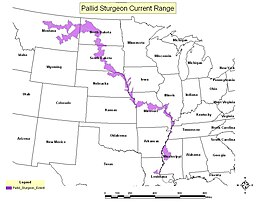| Pallid sturgeon | |
|---|---|

| |
| Scientific classification | |
| Domain: | Eukaryota |
| Kingdom: | Animalia |
| Phylum: | Chordata |
| Class: | Actinopterygii |
| Order: | Acipenseriformes |
| Family: | Acipenseridae |
| Genus: | Scaphirhynchus |
| Species: | S. albus
|
| Binomial name | |
| Scaphirhynchus albus (S. A. Forbes & R. E. Richardson, 1905)
| |

| |
| Pallid sturgeon range | |
| Synonyms | |
|
Parascaphirhynchus albus S. A. Forbes and R. E. Richardson, 1905 | |
The pallid sturgeon (Scaphirhynchus albus) is an endangered species of ray-finned fish, endemic to the waters of the Missouri and lower Mississippi River basins of the United States. It may have even reached the St. Croix River before colonization.
Named for its pale coloration, it is closely related to the relatively common shovelnose sturgeon (Scaphirhynchus platorynchus), but is much larger, averaging between 30 and 60 inches (76 and 152 cm) in length and 85 pounds (39 kg) in weight at maturity.[3][4] This species takes 15 years to mature and spawns infrequently, but can live up to a century. A member of the sturgeon family, Acipenseridae, which originated during the Cretaceous period 70 million years ago, the pallid sturgeon has changed little since then.[5]
In 1990, the U.S. Fish and Wildlife Service placed the pallid sturgeon on its endangered species list because few young individuals had been observed in the preceding decade and sightings had greatly diminished;[6] the species is now rarely seen in the wild. It was the first fish species in the Missouri River drainage area to be listed as endangered, and a loss of its habitat is thought to be responsible for its decline. The vast majority of the Missouri River drainage system has been channeled and dammed, reducing the gravel deposits and slow-moving side channels that are its favored spawning areas. Until the middle of the 20th century, pallid sturgeon were common and anglers found catching such a large fish in fresh water a rewarding experience. The species is considered to be good-tasting, and its eggs have been used as caviar, although less commonly than those of many other sturgeon.[7]
Efforts to prevent the species from becoming extinct have had modest success. Pallid sturgeon are actively being raised in a dozen hatcheries and the offspring are being released back to the wild every year. To better understand pallid sturgeon behavior, researchers have implanted radio transmitters to track their movements and help identify possible spawning areas. Federal and state agencies are working together to improve habitat by restoring spawning areas since restoration of these areas is required if the species is to survive in the wild.
- ^ Jordan, G.; Nelson-Stastny, W. (2022). "Scaphirhynchus albus". IUCN Red List of Threatened Species. 2022: e.T19940A97435395. Retrieved 3 August 2022.
- ^ "Appendices | CITES". cites.org. Retrieved 2022-01-14.
- ^ "Pallid Sturgeon - Scaphirhynchus albus". Montana Fish, Wildlife and Parks. Archived from the original on 2008-11-07. Retrieved 2008-11-19.
- ^ "The Pallid Sturgeon (Scaphirhynchus albus)". Platte River Endangered Species Partnership. Archived from the original on 2007-09-30. Retrieved 2008-11-19.
- ^ "The Pallid Sturgeon, a Missouri River "Dinosaur"". Feature Series, Vol I, No. 4. U.S. Fish and Wildlife Service. Archived from the original on 2008-11-19. Retrieved 2008-11-19.
- ^ "Operation and Maintenance of the Upper Mississippi River 9-Foot Channel". Endangered Species Program. U.S. Fish and Wildlife Service. November 18, 2008. Retrieved 2008-11-19.
- ^ "Threatened and Endangered Species: Pallid Sturgeon Scaphirhynchus Fact Sheet". U.S. Department of Agriculture. November 16, 2005. Archived from the original on November 26, 2005. Retrieved 2008-11-19.
